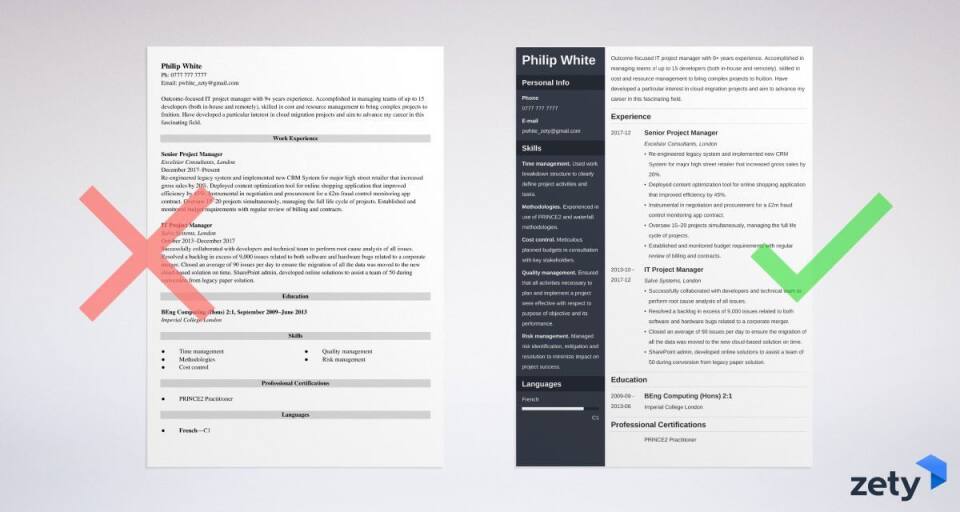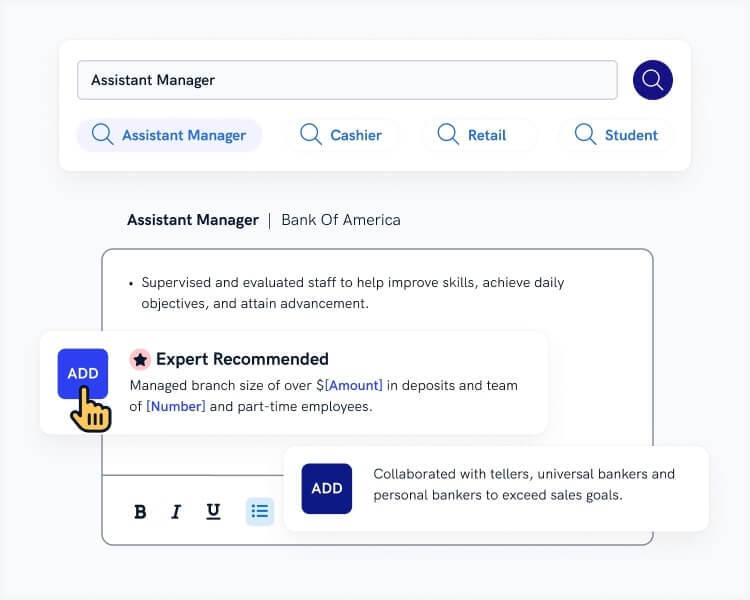Best CV Styles and Which One Should You Choose
Create your CV nowChoosing the right CV style can feel like trying to dress for an interview you haven’t been invited to—yet. Do you go classic and professional? Bold and creative? Strategic and skill-focused?
The truth is, your CV isn’t just a document—it’s your first impression, your pitch, and your proof that you belong in the room. And with recruiters spending mere seconds scanning each application, your choice of format can either open doors… or quietly close them.
Let’s break down the most effective CV styles, when to use each one, and how to make your next application stand out for all the right reasons.
This article will show you:
- Professional CV styles employers and recruiters expect.
- How to choose the best style for your CV to boost employability.
- Uncommon CV variants that might be worth a shot in some situations.
Want to save time and have your CV ready in 5 minutes? Try our CV builder. It’s fast and easy to use. Plus, you’ll get ready-made content to add with one click. See 20+ CV templates and create your CV here.
Sample CV made with our builder—See more CV examples here.
CV Styles Example
Philip White
Ph: 0777 777 7777
Email: pwhite_zety@gmail.com
Outcome-focused IT project manager with 9+ years experience. Accomplished in managing teams of up to 15 developers (both in-house and remotely), skilled in cost and resource management to bring complex projects to fruition. Have developed a particular interest in cloud migration projects and aim to advance my career in this fascinating field.
Work Experience
Senior Project Manager
Excelsior Consultants, London
December 2017–Present
- Re-engineered legacy system and implemented new CRM System for major high street retailer that increased gross sales by 20%.
- Deployed content optimization tool for online shopping application that improved efficiency by 45%.
- Instrumental in negotiation and procurement for a £2m fraud control monitoring app contract.
- Oversaw 15–20 projects simultaneously, managing the full life cycle of projects.
- Established and monitored budget requirements with regular review of billing and contracts.
IT Project Manager
Salve Systems, London
October 2013–December 2017
- Successfully collaborated with developers and technical team to perform root cause analysis of all issues.
- Resolved a backlog in excess of 9,000 issues related to both software and hardware bugs related to a corporate merger.
- Closed an average of 90 issues per day to ensure the migration of all the data was moved to the new cloud-based solution on time.
- SharePoint admin, developed online solutions to assist a team of 50 during conversion from legacy paper solution.
Education
BEng Computing (Hons) 2:1, September 2009–June 2013
Imperial College London
Skills
- Time management. Used work breakdown structure to clearly define project activities and tasks.
- Methodologies. Experienced in use of PRINCE2 and waterfall methodologies.
- Cost control. Meticulous planned budgets in consultation with key stakeholders.
- Quality management. Ensured that all activities necessary to plan and implement a project were effective with respect to purpose of objective and its performance.
- Risk management. Managed risk identification, mitigation and resolution to minimize impact on project success.
Professional Certifications
- PRINCE2 Practitioner
Languages
- French—C1
1. Classic CV Styles
When it comes to CV writing, three time-tested styles have stood the test of recruitment trends: the reverse chronological, functional, and combination CV formats.
Each has its strengths, depending on your career path, goals, and what story you’re trying to tell through your experience.
Chronological CV
The reverse chronological CV is the most widely used format—and for good reason.
This style puts your work history front and centre, starting with your most recent role and working backward. It’s clean, familiar to recruiters, and easily scanned by ATS (Applicant Tracking Systems). If your career has a logical, upward trajectory, this format is the best choice.
Its traditional CV layout and chronological order are perfect for structuring information in an orderly manner. A typical reverse chronological CV consists of the following sections:
- CV header
- CV summary
- Work experience section
- Key skills
- Education section
- Additional sections
The chronological CV style is a great choice for:
- Candidates with a stable or linear career history.
- Professionals aiming for roles within their existing industry.
- Students or early-career applicants (with internships, placements, or education first).
Functional CV
The functional CV, also known as a skills-based CV, flips the script.
Instead of focusing on where you’ve worked, this format highlights what you’re good at—your skills. It’s ideal if you’re transitioning into a new industry, returning to work after a break, or have gaps in your employment you’d rather not emphasise.
A typical layout consists of:
- CV header
- CV profile
- Skills summary
- Additional skills section
- Work history
- Education
This style of CV works best for:
- Creatives who need to have a portfolio of work
- Military transitioners writing their military-to-civilian CVs
- Candidates who don’t want to come across as overqualified.
While this CV style can be powerful for specific scenarios it’s not too popular with recruiters. Why? It’s harder to skim quickly and not always ATS-friendly.
To make it work, be selective: highlight only the most relevant skills for the role, and back them up with concrete examples or achievements.
Combination CV
Can’t choose between showcasing your skills and your experience? The combination CV—or hybrid CV—might be the best of both worlds.
This format blends elements from both the chronological and functional styles. It puts skills and achievements up front, followed by a detailed employment history. It's great for roles that require both proven experience and a specialist skill set.
Typical format includes:
- Contact information
- Skills summary
- Additional skills
- Professional experience/job description
- Education
The combination CV offers flexibility—you can adjust the order of sections to highlight what’s most relevant. That said, this format can be trickier to perfect, and it requires strong judgment to avoid coming across as disorganised.
Best for:
- Career changers
- Professionals with gaps in their employment
- Experienced candidates targeting a specific type of role
2. New CV Styles
With recruiters often reviewing hundreds of applications for a single role, candidates are increasingly experimenting with modern CV styles to make a lasting first impression.
But here’s the truth: not all CV styles suit all roles.
While creative and visual formats can help you shine—especially in design, media, or marketing industries—style should always serve substance. If your CV looks impressive but doesn’t communicate your value, it’s unlikely to get you that callback.
Let’s explore some of the most popular modern CV styles and how to use them effectively.
Creative CV Styles
Creativity on a CV doesn’t mean glitter and gimmicks. It can be as subtle as a unique layout, a custom-designed logo, or a visual element like a skills rating bar. Or it can be bold—a highly stylised, portfolio-inspired page that reflects your personal brand.
Creative CV templates are particularly effective in fields like:
- Graphic design
- Advertising
- Video production
- Digital content creation
Pro Tip: Creative CVs often include non-traditional sections, like “Passion Projects,” “Values,” or “Visual Timeline,” while sometimes omitting standard ones like “Work History” or “References.”
Visual CV Styles
With recruiters spending an average of 6–8 seconds scanning a CV, using visuals strategically can make a big difference. A visual CV template might feature:
- Modern CV fonts and colour accents
- Clean section dividers
- Intuitive layout with plenty of white space
- Iconography or minimalist charts
- Used well, visual styling can draw the eye to your strongest points and create a CV that feels polished and professional.
But be careful not to overdesign. Visuals should support your message—not distract from it. Choose clarity over complexity, and always check formatting compatibility across devices.
Infographic CV Styles
Infographic CVs combine data-driven design with storytelling flair. Think of them as resumes meets visual reports: skills broken into graphs, timelines as flowcharts, and achievements displayed in numbers and icons.
They’re excellent for portfolios, personal websites, or direct-to-hiring-manager submissions—but not for ATS. Applicant Tracking Systems can’t read most infographics properly, so they’ll likely be filtered out.
Infographic CV templates are best for:
- Freelancers sending direct applications
- Portfolio links or presentations
- Professionals in marketing, UX, or analytics
Pro Tip: Make sure both your CV and cover letter are in the same style.
When making a CV in our builder, drag & drop bullet points, skills, and auto-fill the boring stuff. Spell check? Check. Start building your CV here.
When you’re done, Zety’s CV builder will score your CV and tell you exactly how to make it better.
3. CV Styles by Length
When we talk about CV styles, we often think of design and layout—but length is just as important.
How long should a CV be? Well, that depends on your experience, your industry, and what you're trying to communicate. Some roles demand a streamlined one-pager, while others require space to showcase a decade of accomplishments.
Let’s break down the two most common CV lengths and when to use each one.
One-Page CV Style
If there’s one golden rule in job hunting, it’s this: make every word count. A one-page CV is all about precision and punch. It’s ideal for:
- Students and recent graduates
- Entry-level candidates
- Career changers without long work histories
- Professionals applying for roles in fast-paced industries like marketing or tech startups
The main advantage? It forces clarity. With limited space, you’re naturally encouraged to highlight only your most relevant achievements.
Two-Page CV Style
Think one page won’t cut it? You’re probably right—especially if you’ve got years of experience under your belt. A two-page CV is perfectly acceptable and often expected for:
- Mid-level to senior professionals
- Individuals with 10+ years of experience
- Candidates in academia, management, or complex project-based roles
In fact, studies show that over 77% of employers expect longer CVs from experienced professionals. Just remember: more space doesn’t mean more fluff. Every section still needs to earn its place.
Pro Tip: Make sure your CV is free from some typical CV mistakes, and check out our CV writing tips.
4. Current CV Styles
CV trends are a lot like fashion. What’s considered sleek and professional today might feel dated tomorrow.
That said, a few modern CV styles have emerged in recent years that strike the right balance between timeless professionalism and contemporary design. So, let's take a look at them:
Minimalist CV Style
Minimalism isn’t just a trend, but also a design philosophy. And when applied to CVs, it’s all about clarity, focus, and function. Minimalist CVs strip away unnecessary elements and distractions, putting your content centre stage. They rely on:
- Clean typography
- Ample white space
- Simple layouts without decorative elements
- Clear section hierarchy for fast scanning
These CVs are ideal for business professionals, consultants, and applicants in industries where content matters more than colour. They're also highly ATS-friendly and appreciated by recruiters who want fast, digestible information.
Simple & Basic CV Style
Don’t let the word “basic” fool you as this style is far from boring. Basic CV styles are especially well-suited for students and entry-level candidates who may not have a lot of work experience or employment history but who don’t want to fill up their applications with fluff either.
This style focuses on clean formatting and strong content, without trying to dazzle with design. It’s structured, honest, and gets straight to the point.
What makes it effective?
- Easy-to-read fonts
- Standard section ordering (profile, experience, education, skills)
- No graphics or formatting gimmicks
- Compatible with all ATS software
Browse through our selection of blank CV templates and find the one most appealing to you.
Key Takeaways
Here’s all you need to remember about CV styles:
- The most common traditional CV formats are the chronological, functional, and combination styles.
- Popular modern styles include creative, visual, infographic, minimalist, and basic layouts.
- CVs can also be categorised by length, with one-page and two-page formats depending on experience level.
- When choosing a style, think about the industry and company culture—creative roles allow more flexibility, while traditional sectors may expect a classic format.
- Most importantly, ensure your CV is tailored to the job ad, and pair it with a cover letter that matches in tone and design for a polished, professional finish.
Plus, a great cover letter that matches your CV will give you an advantage over other candidates. You can write it in our cover letter builder here. Here's what it may look like:
See more cover letter templates and start writing.
Not sure what CV style to choose? Give us a shout out in the comments below! Always happy to help.
About Zety’s Editorial Process
Our editorial team has thoroughly reviewed this article to ensure it follows Zety’s editorial guidelines. Our dedication lies in sharing our expertise and providing you with actionable career advice that offers you real value. Every year, the quality of our content attracts 40 million readers to our site. But that’s not all – we conduct original research to gain a detailed understanding of the labour market. We take pride in being cited by top universities and leading media outlets in the UK and worldwide.






